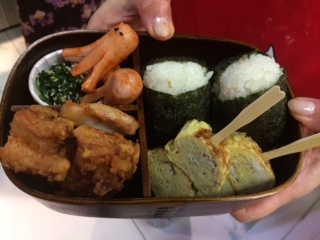Is called Bento and it is the Japanese version of the Milanese schiscetta: for those not accustomed to the Milanese dialect it is the food prepared at home and stored in a special container for the lunch break. In Japan it is a tradition that goes back more than 400 years ago, when the peasants used to take their Bento boxes to the fields while they cultivated the land. Even today it is easy to see groups of boys or men in suits and ties consuming their Bento in the city meadows in the shade of cherry trees in bloom.
Balance and aesthetics
In Japan, preparing the bento box is art, as is composing a bouquet of flowers (ikebana) or offering a cup of tea. The goodness of food cannot be disconnected from the aesthetics of the composition, so every Bento box is an explosion of creativity and refinement. In addition to balance in the association of foods. And among these, you can't miss rice, in the form of onigiri, sushi or inari sushi.
And now we prepare our Bento Box based on onigiri, fried chicken, omelette and boiled rocket
Ingredients for 2 onigiri
80 ml rice, 80 ml water, nori seaweed, 180 g salmon, 1 teaspoon kastuobuoshi (dried tuna), 1/2 teaspoon soy sauce
Method
Let the rice soak for an hour before cooking it. Then pour it into a pot with cold water and bring to a boil. Cook for 10 minutes and then turn off, cover with a lid and let stand 10 minutes more. Once the rice has cooled down, make balls of it, there will be 4. In the meantime, let the salmon soak for half an hour in water with a pinch of salt. Then remove the salmon and spread it on a sheet of foil, spread a pinch of salt on both sides and then wrap it in cling film and let it rest for 30 minutes. Oil a pan and brown the salmon on both sides. Put the dried tuna in a bowl and add a teaspoon of soy sauce. Now make a hole in the center of each rice ball and put a little salmon in it and in the other two a bit of dried tuna mixed with soy. Close up and with your hands formed triangles, which you will wrap with a sheet of nori seaweed. Leave your onigiri aside and dedicate yourself to chicken.
Ingredients for fried chicken
600 g chicken, 1/2 grated apple, 1 teaspoon of grated ginger, 2 tablespoons of sake, 2 tablespoons of soy sauce, 1 teaspoon of salt, 3 tablespoons of potato starch, 3 tablespoons of flour, olive oil for frying
Method
cut the chicken into pieces and leave it in a bowl with the grated apple and ginger, sake, soy and salt. Mix well, cover with a foil and leave to rest in the fridge for 30 minutes. Put the flour and potato starch in a bag and then the chicken pieces. Shake well so that the chicken pieces are covered with flour. Pour the oil in a saucepan, let it heat until it reaches 180 ° and then pour the chicken bites, a few at a time, so that they brown well. Once ready, drain them on a sheet of absorbent paper.
Ingredients for rocket
200 g rocket, 4 tablespoons of toasted white sesame seeds, 2 tablespoons of mirin, 2 tablespoons of sugar, 1 tablespoon of soy sauce.
Method
Boil the rocket in hot water and then drain it in a bowl with ice. In a mortar, mince the sesame seeds and then add the mirin, sugar and soy and mix. Meanwhile drain the rocket, squeeze it and cut it into a banner. Then add the rocket with sesame seeds and stir.
Ingredients for the omelette
2 eggs, a tablespoon of mirin, 1/2 spoon sugar, 1/2 teaspoon of soy sauce, oil for frying.
Method
in a bowl beat the eggs, then add the sugar, the mirin, the soy sauce and mix well. Oil a rectangular pan, separate the eggs into three parts and cook one at a time, rolling it up on itself each time, using a spatula. Then put the rolled omelette on the makisu (stuoietta), roll it well and let it rest. Then gently open the makisu and cut the omelette into 8 pieces, which you will slice through two on wooden sticks.
Ingredients for wustel
2 wustel, 2 teaspoons of ketchup, sesame seeds, olive oil.
Method
Cut the wustel in half and then with a sharp knife cut it vertically to form the 8 tentacles of the octopus. Oil a pan and then crush the wustel from above so that the tentacles divide and cook well. Then add the ketchup and stir. Attach two black sesame seeds as eyes to each wustel to create the eyes of the octopus.
At this point all the ingredients are placed in the Bento Box: the onigiri, the skewers of omelette, the pieces of chicken and the rocket with the baby octopus. Your Bento Box is ready to be enjoyed, even with your eyes!

